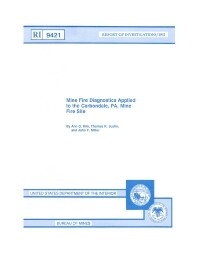Mining Publication: Mine Fire Diagnostics Applied to the Carbondale, PA Mine Fire Site
Original creation date: January 1992
Authors: AG Kim, TR Justin, JF Miller
NIOSHTIC2 Number: 10011398
U.S. Department of the Interior, Bureau of Mines, Report of Investigations 9421, 1992 Jan:1-16
The U.S. Bureau of Mines applied its mine fire diagnostic method to an abandoned anthracite mine fire site in Carbondale, Lackawanna County, Pennsylvania. The technique to locate fires in abandoned coal mines and coal refuse piles includes the determination of hydrocarbon concentrations in mine gases, the imposition of an underground gas flow direction, and use of a surface mapping method to define heated and cold zones in underground coal strata. The heated zones at Carbondale were characterized by elevated methane concentrations. The results of 25 communication tests were analyzed to define 2 large (approximately 100 by 250 ft) and 5 small, isolated heated zones. An approximate correlation existed between the location of the heated zones and areas of anomalous snow melt. The correlation between the results of the diagnostic test and subsurface temperatures was not significant.

NIOSHTIC2 Number: 10011398
U.S. Department of the Interior, Bureau of Mines, Report of Investigations 9421, 1992 Jan:1-16